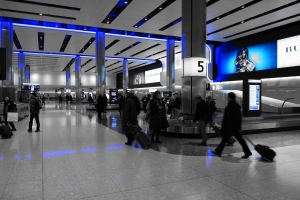
The United States may boast the world’s top economy, but that’s not evident when travelers arrive at America’s front door. The country’s airports do not impress international travelers. Not even one American airport is listed in the top 25 in Skytrax’s 2016 survey of the world’s best airports. In fact, U.S. airports are so far down the list, it is shocking.
Operational inefficiencies, passenger congestion, limited retail, access in and out of terminals and the negative passenger experience found in almost every U.S. airport is the result of outdated design, increasingly high demand, a lack of funding investment and a tendency to reject the concept of collaborating with private-sector experts. That, however, is changing.
Big changes are occurring in the U.S. and more are expected soon. In fact, airport modernization in America is expected to outpace all other countries in the next few years.
 Los Angeles International Airport (LAX), historically notorious for subpar facilities, has launched a $14 billion modernization project. More gates are available to service the massive Airbus A380 jets, retail ranges from Armani and Porsche to KFC and passengers are treated to all types of new amenities at the Tom Bradley International Terminal. A “people-mover” train will allow travelers to have quick access to terminals, car rental facilities, parking garages and automated kiosks for quick boarding.
Los Angeles International Airport (LAX), historically notorious for subpar facilities, has launched a $14 billion modernization project. More gates are available to service the massive Airbus A380 jets, retail ranges from Armani and Porsche to KFC and passengers are treated to all types of new amenities at the Tom Bradley International Terminal. A “people-mover” train will allow travelers to have quick access to terminals, car rental facilities, parking garages and automated kiosks for quick boarding.
New York’s LaGuardia Airport has allocated $4 billion in funding to bring that facility up to first-world standards. The John F. Kennedy International Airport (JFK) will also be renovated. Chicago’s O’Hare Airport is undergoing improvements through a $15 billion O’Hare Modernization Project. Major changes are coming to U.S. airports – but none too soon.
The modernization trend will reach other U.S. cities as well. The city of Houston has announced a major modernization project at the George Bush International Airport. San Antonio city officials are hoping to do the same.
It will be interesting to see which cities follow a trend that has proved successful in other countries – the privatization of airport terminals and overall operations. Many cities have seen the success of collaborating with airport experts in other countries and many have engaged in public-private partnerships (P3/PPPs). Most airports build a repayment revenue plan around the increased revenue that is generated inside the modernized terminals.
The Hartsfield-Jackson airport in Atlanta, Ga., plans to spend approximately $6 billion to modernize its facilities. An “industry day” will be held so that interested private-sector contractors can learn more about the city’s ATLNext plan for the airport.
Kansas City International Airport in Missouri will get at least a $1 billion upgrade. And, Ohio’s Port Columbus International Airport has announced an immediate $80 million modernization plan as well as a $1.3 billion expansion that is still in the planning stages.
About $2.7 billion has already been allocated for upgrades to Hawaii’s airports. Honolulu International Airport has invested $750 million to modernize its facilities and other airports are still in the planning phases for large projects.
America’s airports are in “catch-up” mode and that process should move rapidly to all airports located in the U.S. Because of the activity, airport contractors and operators throughout the world have a laser focus on what is now happening at airports in U.S. cities.
